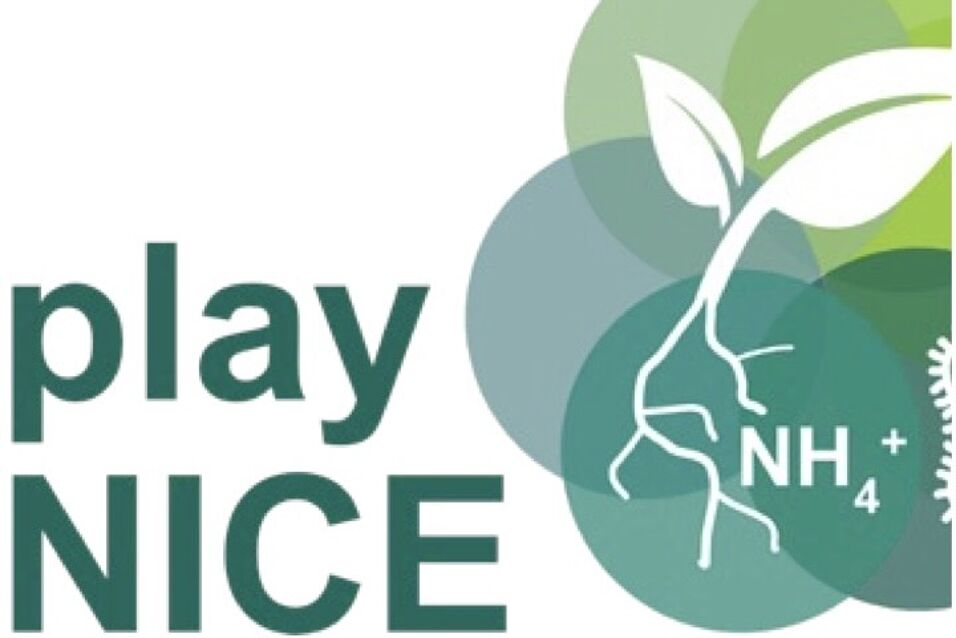About a century ago, industrial N fixation via the Haber-Bosch process (N2 + 3H2→ 2NH3) was invented, massively accelerating and perturbing the global N cycle. Today, ~80% of industrially fixed N is used to produce fertilizer, resulting in steadily increasing agricultural production. Industrial N fixation enabled us to nutritionally sustain the global population increase of the 20th century, and is currently indirectly feeding half of the world’s population.
Besides the intended effect of increasing agricultural yield, N fertilization has unintended consequences, many of which we have only recently started to grasp. The poor nitrogen use efficiency (NUE) of agriculture, a measure for the amount of N retained in food per amount of fertilizer N applied, leads to massive fertilizer N losses (~40%) to the environment, where it amplifies eutrophication of aquatic ecosystems, and causes changes in atmospheric chemistry and climate. Reducing N loss and increasing NUE in agriculture is thus essential to mitigate the negative effects of N fertilization. Currently, synthetic nitrification inhibitors are widely used to reduce the detrimental effects of fertilizer N loss from agricultural ecosystems, while the potential of biological, plant derived nitrification inhibitors is not yet known.
Why use nitrification inhibitors to reduce fertilizer loss?
The first step of nitrification can be carried out by three groups of microorganisms, the ammonia-oxidizing bacteria and archaea (AOB and AOA), and complete ammonia-oxidizing bacteria (comammox). All three groups of ammonia oxidizers utilize NH3 as their main energy source, a reaction catalyzed by ammonia monooxygenase (AMO) enzymes. Given that AMOs are essential for the activity of all aerobic ammonia oxidizers, possess a wide substrate range, and are responsible for the first step in the process of nitrification, they are an ideal target for inhibition.
In contrast to most other microorganisms involved in terrestrial N cycle processes, nitrifying microorganisms are highly specialized, and are displaying similar physiology and enzymology. Generally, nitrification rates are low in N limited soils, but about 90% of N in fertilized soils flows through the nitrification pathway. This makes the process of nitrification an attractive inhibition target to prevent N loss from agricultural soils.
Synthetic nitrification inhibitors (SNIs) vs. biological nitrification inhibitors (BNIs)
Currently, synthetic nitrification inhibitors (SNIs) are widely used to reduce the detrimental effects of fertilizer N loss from agricultural ecosystems. However, several SNIs have been shown to negatively impact plant growth and health. Perhaps most troubling is that some SNIs can bioaccumulate in plants and animals. Therefore, plant derived compounds that inhibit nitrification, called biological nitrification inhibitors (BNIs), have recently received increased attention as safer and potentially more effective alternatives to SNIs.
Previous research has shown that BNIs in crop root exudates can suppress up to 90% of nitrification activity in soil and increase soil N retention. Thus, BNIs are a viable alternative to the currently used SNIs and can provide plants with a competitive advantage for fertilizer N. Exploiting the intrinsic plant potential to produce BNIs is a promising path towards more sustainable agriculture. However, before BNIs can be applied in agricultural practices, a deeper understanding of their effect on overall soil microbiology, plant health and nutrition, and the N-cycle in general must be established.
The playNICE project aims to:
- Identify (novel) BNIs naturally secreted in the root exudates of common crop plants.
- Evaluate the efficacy and inhibition mechanism of BNIs and their degradation products.
- Determine the effect of BNIs and their degradation products on soil microbially-mediated biogeochemical processes in soil (nitrification, denitrification, nitrogen fixation) as well as microbial respiration, and microbial carbon use efficiency.
- Determine the mobility, residence time, and degradation products of BNIs.
- Assess the efficacy of BNIs in increasing N retention in soil and N transfer into crops.
Current publications from playNICE:
The playNICE Team:
- Petra Pjevac (principal investigator, coordinator): Division of Microbial Ecology, Centre for Microbiology and Environmental Systems Science, University of Vienna; Joint Microbiome Facility, Medical University of Vienna and the University of Vienna.
- Christoph Bueschl (principal investigator): Institute of Bioanalytics and Agro-Metabolomics, Department of Agrobiotechnology (IFA-Tulln), University of Natural Resources and Life Sciences, Vienna (BOKU)
- Lucia Fuchslueger (principal investigator): Division of Terrestrial Ecosystem Research, Centre for Microbiology and Environmental Systems Science, University of Vienna.
- Andrew Giguere (principal investigator): Division of Microbial Ecology, Centre for Microbiology and Environmental Systems Science, University of Vienna.
- Chris Sedlacek (principal investigator): Division of Microbial Ecology, Centre for Microbiology and Environmental Systems Science, University of Vienna.
- Maria Doppler (Post-doc): Institute of Bioanalytics and Agro-Metabolomics, Department of Agrobiotechnology (IFA-Tulln), University of Natural Resources and Life Sciences, Vienna (BOKU)
If you would like to contact the team or are interested in joining, please contact Petra Pjevac.
This project is funded by the Young Independent Researcher Groups (YIRG) Program of the Austrian Science Fund (ZK 74 Zukunftskolleg).



